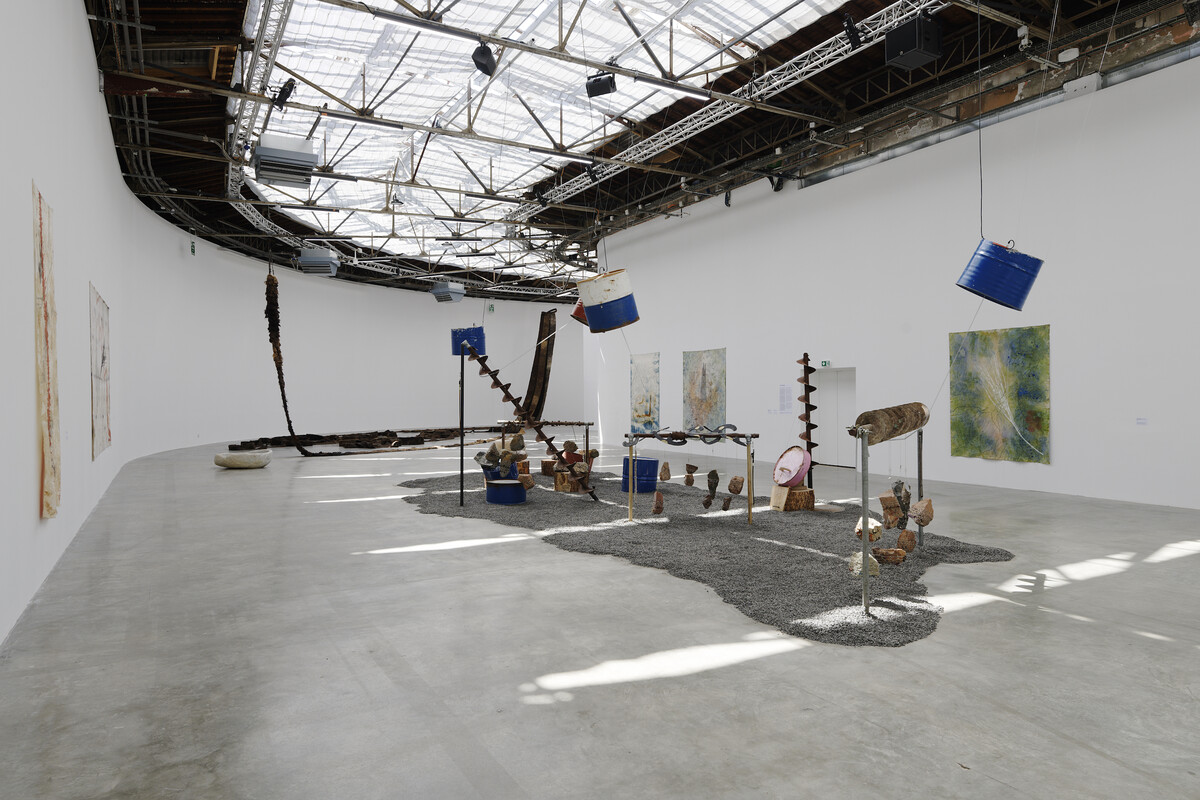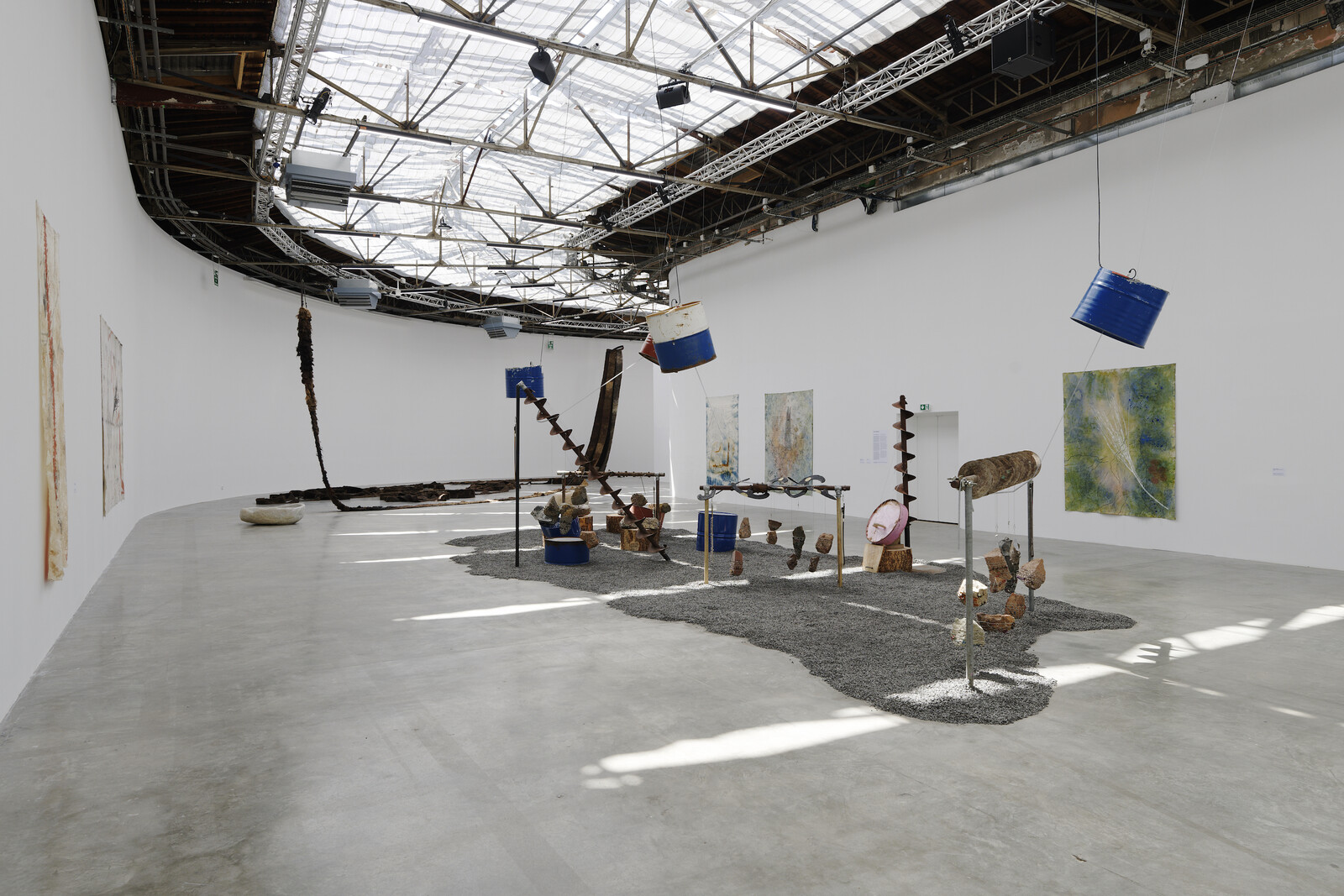“Ecological turns” is a series in which writers consider how the ecological discourse is shaping the production, exhibition, and reception of contemporary art. In this instalment, Natasha Marie Llorens reflects on a group exhibition at Palais de Tokyo which takes a “rallying cry” for a title: “Reclaim the Earth.”
Solange Pessoa’s long swaths of felted horsehair, culled and woven together over many years, are suspended from the Palais de Tokyo’s high ceilings, their rough surfaces and variegated brown tones visible from a distance as I enter the gallery. Cathedral (1990–2003) is part of a group show entitled “Reclaim the Earth,” encompassing the work of fourteen artists, conceived as a multi-generational and multi-cultural “rallying cry” in response to climate collapse. Pessoa’s references to horses imported to Brazil by the Spanish are described by the wall label as evocative of “distant memories of Brazil’s colonization by the Europeans,” and the artist’s contribution to the exhibition is summarized as animating “both living and non-living elements, mixing present time with the ancestral past.”1 I am attracted to the abject quality of Pessoa’s lines traced over the ghost image of Oscar Niemeyer’s Brasilia Cathedral, but I balk at the softness of the generalization “European colonization,” and at the suggestion that the colonizers’ past in Brazil is “ancestral.” The wall text suggests an analogy between the ancestors of Indigenous peoples and those of Spanish mercenaries and priests that obscures the violence which shaped these lives so differently. I wonder who benefits from that rhetorical obscurity.
“Reclaim the Earth,” curated by Daria de Beauvais with the assistance of Lisa Colin, is a beautiful show. Kate Newby’s delicate installation of found glass shards and Limoges porcelain shells, it makes my day so much better if I speak to all of you. (2022) spreads across the floor at the entrance to one of the exhibition rooms like a small universe of microcosms, a glittering re-valuation of urban detritus. The Karrabing Film Collective presents The Family and the Zombie (2021), a deliciously irreverent zombie movie starring a group of Aboriginal children and anthropologist Elizabeth Povinelli (as the zombie) luxuriously installed on large walls in a dedicated black box that doubles as an eerie post-apocalyptic landscape of broken-down cars and jumbled piles of motorized scooters. Yet the strongest connection between Povinelli playing the white monster to the delight of children and Pessoa’s laborious, abject minimalism is the fact that colonialism destroyed the land both in Brazil and in Australia—the specificity of which lies outside the curatorial justification for placing these works together. Observing a group of monumental wooden sculptures by Huma Bhabha—The Past is a Foreign Country (2019), Receiver (2019) and God of Some Things (2011), each an amalgamation of found materials and aesthetic archetypes—I wonder whether these imposing figures are here as witnesses to the destruction of the earth, and, if so, by whom? Are they aligned with the curatorial imperative to reclaim something—experience, territory, ecological connection—or are they warning the viewer? Again, some specificity is missing about the connection between climate collapse and colonialism, between colonialism and racism, or between Bhabha’s massive and grief-stricken distortions of the human figure and the idea of reclamation.
Throughout “Reclaim the Earth,” this lack of specificity disturbs me. In the absence of contextual detail, the show evades the problem of what happened to the earth in the first place, who benefited from its destruction, whose descendants continue to hold power because of that benefit, and, ultimately, to whom the labor of reparation falls. This is not solely rhetorical criticism; without specificity, the exhibition forecloses the possibility of profound reclamation or healing in human societies’ relationship to the earth, undoing the very work it claims to be committing to.
The problems inherent to decontextualizing artwork through global exhibition-making have been debated for decades. Admittedly, there is no easy resolution. One of the key turning points was the controversy surrounding “Magiciens de la Terre,” the landmark 1989 exhibition presenting artwork by over 100 international artists, curated by Jean-Hubert Martin in lieu of a more traditional Biennale de Paris. Hubert’s ambition was to demonstrate the universal nature of aesthetics and to break down the hierarchical relation between artists working in what he called the “Non-West” and well-established artists based in Europe and North America.
That same year, Karachi-born and London-based artist Rasheed Araeen wrote a critique of “Magiciens de la Terre” that was assigned to me in the first class of my MA program in curatorial studies more than a decade ago, and that remains canonical in decolonial curatorial studies today. Araeen’s main criticism challenges the basis for Hubert’s claim for aesthetic universality. Briefly put, Araeen argues that artworks cannot be abstracted from their historical formations without voiding their relevance to the socio-political field to which they respond. The enduring question for the field of curatorial practice in the wake of “Magiciens de la Terre” is how a conceptual framework can counter this abstraction or compensate for the displacement of artworks, especially those invested in the subtlety of historical formations. “My main criticism,” wrote Araeen, after praising the quality and attractiveness of work on show, “concerns the lack of any radical theoretical or conceptual framework that can justify the togetherness of works which represent different historical formations.”2 Three decades later, his observations succinctly clarify my own discomfort with “Reclaim the Earth.”
The consequence of Araeen’s argument for the curatorial field is a widespread—I think—recognition that abstracting Indigenous artworks, or artwork about Indigeneity, from the context of their historical formation is politically questionable. The logical continuation of this argument is that it is not possible to “reclaim the earth” in an abstract sense. This work must be done on the ground, so to speak, with the murderous ideological complexity of specific places fully in view. This means that any curatorial framework must take seriously its responsibility to compensate for the displacement of abstract forms like Pessoa’s. “Reclaim the Earth” does not provide that kind of contextualization. “It is in their decontextualization,” Araeen wrote of the works by Indigenous artists in the 1989 exhibition, “not only in the shift from one culture to another (which is inevitable), but more importantly, in the displacement from one paradigm to another; this has emptied them of their meanings, leaving only what Fredric Jameson calls a ‘play of surfaces’ to dazzle the (dominant) eye.”3 The displacement in “Reclaim the Earth” functions in a similar manner by showing artwork addressed to very different, specific paradigms of coloniality side by side, with only the nebulous concept of “the earth” to bind them conceptually.
This nebulousness produces a second problem. Though the curatorial statement for “Reclaim the Earth” claims to be listening to a “rallying cry” sent out by artists, it simultaneously positions the Palais de Tokyo as an infrastructure for reparative witnessing, the platform from which symbolic reparations can be initiated. The Palais de Tokyo is represented as a sort of neutral space, stabilized by a dearth of artists who make work that implicates French institutions in the economic interests underpinning climate collapse. Even when the exhibition does address French colonial history, an effort is made to place violence in the past. The wall label for Daniela Ortiz’s biting politically satirical series of paintings The Rebellion of the Roots (2020–ongoing) notes that
Ortiz depicts tropical plants that seem to be protected and nurtured by the spirits of victims of European colonialism. For too long “kidnapped” (according to the artist), the plants confront the politicians and authorities responsible for these crimes. Through her small formats, the artist instils a spirit of resistance and calls for the need to support existing anticolonial struggles.4
The paintings depict a fictional story composed by the artist about anthropomorphic plants. Why is it necessary to place the narrative action—the fact that the plants were kidnapped—in quotation marks and attribute this interpretation to the artist, if not to produce a vagueness around the figure of the perpetrator? The wall label’s distortions come into even starker relief when compared to other curatorial framings of the same work. In a solo presentation of the series as part of Kadist’s collection in Paris, Ortiz’s paintings are described in these terms:
The Rebellion of Roots by Daniela Ortiz depicts a series of situations in which tropical plants, held hostage in the botanical gardens and greenhouses of Europe, are protected and nurtured by the spirits of racialized people who died as a result of European racism. […] In the paintings, the plants create their own forms of justice by confronting the authorities and institutions that perpetuate structural racism. In particular, the series exposes the violent influence of French colonialism around the world.5
In the text for Kadist, the violence against people of color is in the present, the perpetrators are alive and among us, and racism is named as an integral aspect of the ecological destruction unfolding in real time. An ethically defensible reclamation of the earth cannot begin without this fundamental admission.
Without a clear articulation of the role colonialism and racism have played in climate collapse, it is also impossible to answer my most burning question about the exhibition: Who is addressed by the curatorial imperative to “reclaim the earth”? The display of Thu-Van Tran’s work lays bare the exhibition’s muddled positioning from a different perspective. In Tran’s immersive installation From Green to Orange – Invasive Alien Species (2022), the relationship to the earth is clear. The work is composed of photographs taken during the artist’s search for a rubber plantation in the Amazon basin in 2015. Eight large photographic panels depict dense vegetation, plants which are either toxic to humans or invasive species resulting from human intervention in the Amazonian ecosystem. The curatorial framework also makes a clear link between what is represented in Tran’s work and the ecological task confronting human societies: “This herbarium, subjective and immersive, questions the cohabitation and hybridization of these plants, as well as our relations with them.”6 But that “us,” crucially, is ambiguous. “We” do not all have the same relations with the earth, nor do “we” all share the same responsibility for its spoilation. Is this imperative directed to French people descended from the formerly colonized, or those who—like the artist herself—sought refuge in France from political upheaval in its former colonies?
Tran’s work—like most of the pieces included in “Reclaim the Earth”—is polyvalent, articulating what remains visible in the wake of chemical processes (she soaked the photographs in successive chemical baths before mounting them) and evoking the historical migrations that such chemical processes mirror. Is this work asking a Parisian audience to reclaim the earth, or to reconsider the trace appearance of violent histories in the landscape? I think the latter interpretation is more faithful to the work.
“Reclaim the Earth” wants to participate in a broader conversation about the role of art at a moment of catastrophic crisis, but it is presented at an institution that—in this case at least—neither relinquishes its traditional universalist prerogative nor foregrounds the fact that European colonization is the primary vector for this crisis. Instead, a series of individually transformative artworks are employed as markers of a discourse that would dismantle the universalism of an exhibition space, in a space that does not allow for the possibility of that change.
“Reclaim the Earth” is at Palais de Tokyo, Paris through September 9, 2022.
Wall text for “Reclaim the Earth” at Palais de Tokyo, Paris, May 2022.
Rasheed Araeen, “Our Bauhaus, Others Mudhouse,” Third Text, no. 6 (Spring 1989): 7.
Ibid, 9.
Wall text for “Reclaim the Earth” at Palais de Tokyo, Paris, May 2022
“Daniela Ortiz: The Rebellion of the Roots (France),” 2021, https://kadist.org/work/the-rebellion-of-the-roots-france/
“Thu-Van Tran”, https://palaisdetokyo.com/en/personne/thu-van-tran/


